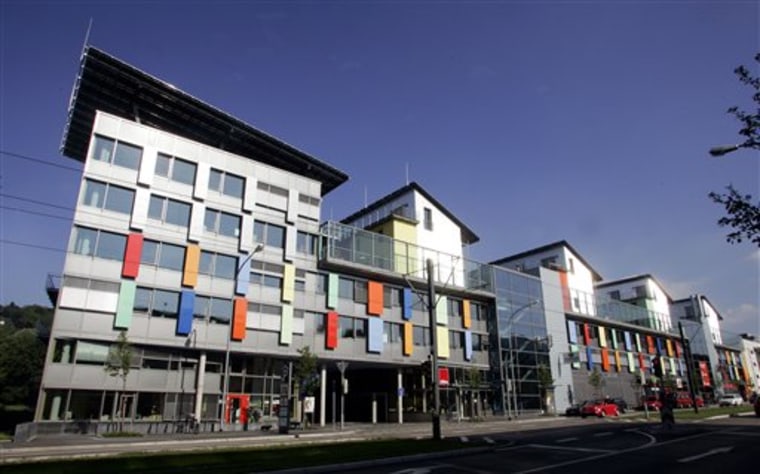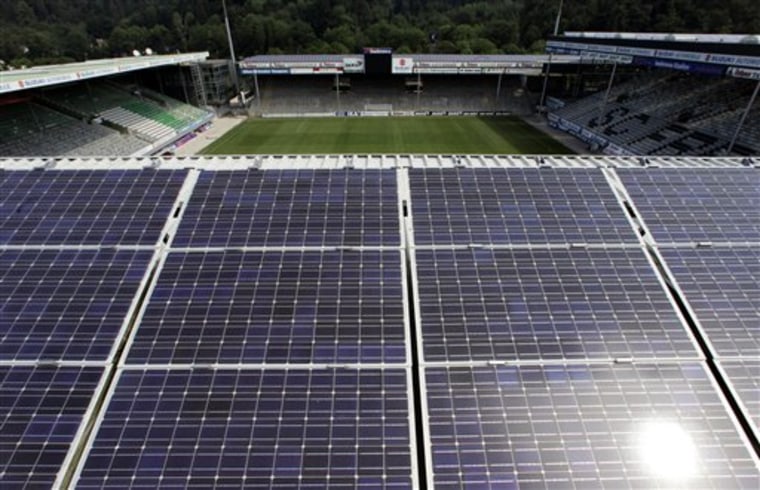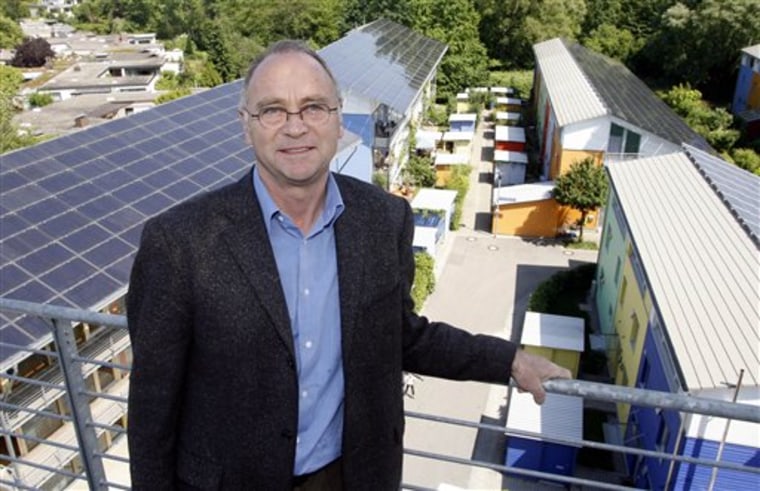Solar architect Rolf Disch's house looks like an upside down Apollo spacecraft and serves as a testing ground for his design ideas. Its large windows look out on his projects realized throughout Freiburg.
The home slowly turns with the sun, to charge a billboard-sized solar panel on the roof, and the waterless toilet emits an occasional malodorous whiff. Hanna Lehmann, Disch's wife, said she does not mind these features but admitted she would like to have a freezer, which would eat up too much electricity for her husband.
"I miss my Campari on ice," she said.
Disch and Freiburg are pioneers in energy saving, and a growing number of eco-tourists flock here to admire his house, known as the Heliotrope, from the Greek words for "sun" and "turn." Across the city, solar panels are on everything from the soccer stadium to entire neighborhoods with homes that produce more energy than they use.
"Energy was too cheap for people to take it seriously, but with the rise in energy costs and the IPCC report people see that they have to look for other solutions now," Disch said, referring to the U.N.'s Intergovernmental Panel on Climate Change, which documented scientific evidence for global warming.
With its focus on solar energy, Freiburg demonstrates the progress that can be made by promoting, developing and using renewable energy. But the city of more than 200,000 in the sunny southwestern corner of the country also is an example of how far technology in the solar sector has to go — it produces less than 1 percent of its electricity from the sun.
Roots against nuclear power
Residents boast that Freiburg's solar power roots go back to a protest in 1975 against plans for a nuclear plant.
"They didn't want nuclear power in their backyards and fields," said Thomas Dresel of the city's Environmental Protection Agency, noting that not only students but farmers demonstrated.

The protest also drew experts who helped develop alternative energy solutions, Dresel said. The region now has more than 900 solar installations and is home to leading research institutions and companies working to make renewable energy more practical.
In 1981, the Fraunhofer Institute for Solar Energy Systems was founded in Freiburg, and a number of like facilities followed. Fraunhofer now employs some 500 people and is Europe's largest solar energy research institute.
Germany as a whole has followed Freiburg's lead in trying to save energy, encouraged by the environmentally friendly Green Party that was in former Chancellor Gerhard Schroeder's governing coalition. In 2000, Germany decided to phase out nuclear plants by 2020, and it has adopted legislation promoting the development and use of renewables.
Renewable energy made up more than 5 percent of the country's total primary energy supply in 2006, according to its Federal Environment Ministry. The government's goal is to increase the share of electric power sourced from renewables to 12.5 percent by 2010 and 20 percent by 2020.
Growth in solar industry
Wind energy remains the country's leading renewable for electricity generation, but the use of solar has increased to approximately 750 megawatts installed in 2006, up from 83 megawatts in 2002, according to the German Solar Industry Association.
The solar industry is becoming a $7 billion a year business that builds more than 50 percent of the world's installed solar panels. About 43,000 people work in the industry, according to the association.
The federal government has spent more than $1.7 billion in photovoltaic research since the late 1990s.
"Germany is technologically leading in solar technology, most solar plants are installed here and, what is even more important, are produced here," said Carsten Koernig, head of the German Solar Industry Association. "And this is the decisive factor, because other countries will follow and then we want to supply these huge growth markets with solar technology 'made in Germany.'"

In Freiburg, the city government started encouraging saving power as early as 1986 when it called for greater energy efficiency, new technology and more renewable sources. Karin Schneider, Fraunhofer's spokeswoman, said this decision was "a direct reaction" to the Chernobyl nuclear disaster in Ukraine the same year.
"The community here was very open to renewables," she said. "And there has always been a good collaboration between us, the city council and other institutes and facilities."
Freiburg's regular sunshine — over half the year is sunny — is better for the city's image as an innovator of solar energy than for increasing the electricity generated. Dresel said the level of sunshine gets significantly higher much farther south, "but it doesn't really matter if we're here or in the rest of Europe."
One district goes to extreme
Although the vast majority of residents still live under traditional tile roof homes, those built in the renovated Vauban district have been required to follow low-energy standards.
Vauban includes passive houses — with triple-thick glass windows and walls of compressed natural materials — that help create all the energy they will need. These cost around 15 percent more than a conventional house, according to Disch.
The passive houses are located within a district with strict limits on car traffic, where families on bikes take up the streets, some pulling carts to carry goods and others leading their dogs on leashes.
Some critics ridicule the scene, joking that passive home residents make their own breakfast cereals, shunning store-bought brands. Others find irony shining from the solar panels mounted on a parking garage.
Despite the jokes, a renewable-minded culture has been developing among Freiburg's people.
"Plus energy" apartments designed by Disch atop the Solar Ship, a mixed residential and commercial building that contains an organic grocery and his architectural firm, each have solar panels that create four times more energy than the apartments consume.
The headquarters of solar panel maker Solar-Fabrik applies similar techniques for the workplace. It features a photovoltaic facade and a generator run on vegetable oil that together creates all the energy needed for the building.
The power company Badenova says about 10 percent of its customers now opt for a higher bill to support greater use of regional and renewable energy.
Solar soccer
Another initiative combines solar technology and sport. The city's soccer team showers after games with water heated by solar panels on the stadium roof. The team gave season tickets to investors in the project.
Other panels on the stadium earn money by feeding electricity into the power grid and were financed by a partnership of local team SC Freiburg and Badenova, which offered public shares in the project.
For all Freiburg's efforts to use renewable energy, Dresel of the Environmental Protection Agency admits with a half-kidding reluctance that solar only comprises 0.74 percent of the city's electricity supply.

"For the time being, its still very small, but the qualitative aspect is very strong," Dresel said. "This creates momentum for the future."
Renewable energy in the Freiburg region makes up almost 4 percent of energy production. The city has set a target of 10 percent of renewable usage by 2010. Freiburg already has set some low energy requirements for home buyers.
It helped that Germany's Renewable Energy Sources Act, passed in 2000, set a healthy price to be paid for renewable energy fed into the electricity grid, and that figure was revised upward in 2004.
But even in this pioneering city for renewable energy, Disch complains that he has to be as creative in getting money for his projects as he is in designing them.
"It's getting less difficult," he said, "but it's still hard."
